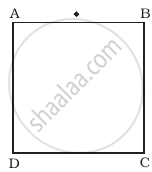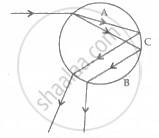Advertisements
Advertisements
Question
Choose the correct option.
Select the WRONG statement.
Options
Smaller angle of prism is recommended for greater angular dispersion.
Right-angled isosceles glass prism is commonly used for total internal reflection.
Angle of deviation is practically constant for thin prisms.
For emergent rays to be possible from the second refracting surface, certain minimum angle of incidence is necessary from the first surface.
Solution
Smaller angle of prism is recommended for greater angular dispersion.
APPEARS IN
RELATED QUESTIONS
State the conditions required for total internal reflection of light to take place
The diagram below shows a point source P inside a water container. Four rays A, B, C, D starting from the source P are shown up to the water surface

1) Show in the diagram the path of these rays after striking the water surface.
The Critical Angle for the water-air surface is 48°.
2) Name the phenomenon which the rays B and D exhibit.
State the relation between the critical angle and the absolute refractive index of a medium.
Angle of deviation is the angle which the ______ ray makes with the direction of ______ray.
A light ray does not bend at the boundary in passing from one medium to the other medium if the angle of incident is ______.
Draw diagram to illustrate the total internal reflection.
Write the relation between the refractive index and critical angle for a given pair of optical media?
Calculate the speed of light in a medium whose critical angle is 30° ?
Swarali has got the following observations while doing an experiment. Answer her questions with the help of observations.
Swarali observed that the light bent away from the normal, while travelling from dense medium to rarer medium. When Swarali increased the values of angle of incidence (i), the values of angle of refraction (r) went on increasing. But at a certain angle of incidence, the light rays returned into the dense medium.
So, Swarali has some questions. Answer them –
a) Name this certain value of ‘i ’. What is the value of ‘r’ at that time ?
b) Name this process of returning of light in dense medium. Explain the process.
The observation made by Swarali while doing the experiment is given below. Based on these write answers to the questions:
Swarali found that the light ray travelling from the denser medium to rarer medium goes away from the normal. If the angle of incidence (i) is raised by Swarali, the angle of refraction (r) went on increasing. However, after certain value of the angle of incidence the light ray is seen to return back into the denser medium.
Questions:
- What is the specific value of∠i called?
- What is the process of reflection of incident rays into denser medium called?
- Draw the diagrams of three observations made by Swarali.
Plot a graph between
Sine of angle of incidence versus sine of angle of refraction,
How does a ray of light bend when it travels from rarer to denser medium
How does a ray of light bend when it travels from when it is normal to the interface of the two media.
How is the critical angle of a material related to its refractive index?
A ray of light is incident on a glass surface at an angle of 50° with the corresponding angle of refraction 30°. Find the value of the R.I. of glass.
Choose the correct option.
Angles of deviation for extreme colours are given for different prisms. Select the one having maximum dispersive power of its material.
Which of the following is not involved in formation of a rainbow?
Answer the following question.
Under what conditions are total internal reflection possible? Explain it with a suitable example.
Answer the following question.
Describe the construction and working of an optical fibre.
Answer the following question.
Why is prism binoculars preferred over traditional binoculars? Describe its working in brief.
Write any two uses of total internal reflection.
What are the examples of total internal reflection in nature?
The phenomena involved in the reflection of radiowaves by ionosphere is similar to ______.
A rectangular block of glass ABCD has a refractive index 1.6. A pin is placed midway on the face AB (Figure). When observed from the face AD, the pin shall ______.

- appear to be near A.
- appear to be near D.
- appear to be at the centre of AD.
- not be seen at all.
State the condition under which total internal reflection occurs. Give the mathematical expression for total internal reflection.
Observe the given figure of the raindrop and answer the following questions:

- Label A and B of the given diagram. Why colour will deviate most.
- Name the phenomenon shown in label C.
A given ray of light suffers minimum deviation in an equilateral prism P. Additional prism Q and R of identical shape and of the same material as P are now added as shown in the figure. The ray will now suffer ______.

- Assertion (A): Propagation of light through an optical fibre is due to total internal reflection taking place at the core-cladding interface.
- Reason (R): Refractive index of the material of the cladding of the optical fibre is greater than that of the core.
An endoscope uses optic fiber to transmit high resolution images of internal organs without loss of information. The principle of light that is used by the optic fiber is based on ______.
State two differences between normal reflection and total internal reflection.
